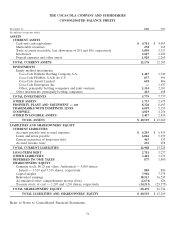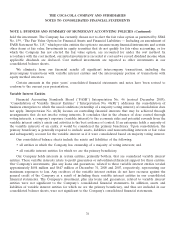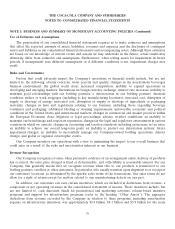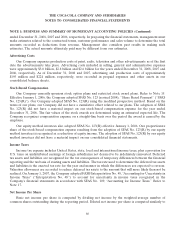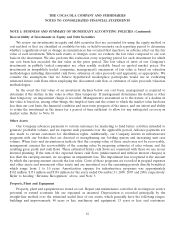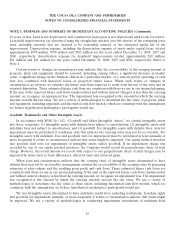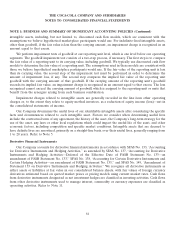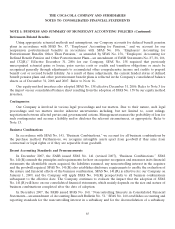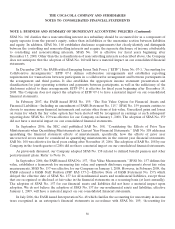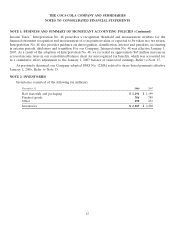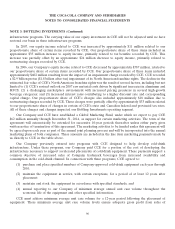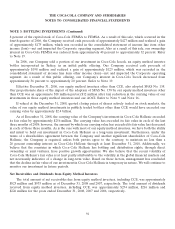Coca Cola 2008 Annual Report Download - page 86
Download and view the complete annual report
Please find page 86 of the 2008 Coca Cola annual report below. You can navigate through the pages in the report by either clicking on the pages listed below, or by using the keyword search tool below to find specific information within the annual report.THE COCA-COLA COMPANY AND SUBSIDIARIES
NOTES TO CONSOLIDATED FINANCIAL STATEMENTS
NOTE 1: BUSINESS AND SUMMARY OF SIGNIFICANT ACCOUNTING POLICIES (Continued)
intangible assets, including, but not limited to, discounted cash flow models, which are consistent with the
assumptions we believe hypothetical marketplace participants would use. For indefinite-lived intangible assets,
other than goodwill, if the fair value is less than the carrying amount, an impairment charge is recognized in an
amount equal to that excess.
We perform impairment tests of goodwill at our reporting unit level, which is one level below our operating
segments. The goodwill impairment test consists of a two-step process, if necessary. The first step is to compare
the fair value of a reporting unit to its carrying value, including goodwill. We typically use discounted cash flow
models to determine the fair value of a reporting unit. The assumptions used in these models are consistent with
those we believe hypothetical marketplace participants would use. If the fair value of the reporting unit is less
than its carrying value, the second step of the impairment test must be performed in order to determine the
amount of impairment loss, if any. The second step compares the implied fair value of the reporting unit
goodwill with the carrying amount of that goodwill. If the carrying amount of the reporting unit’s goodwill
exceeds its implied fair value, an impairment charge is recognized in an amount equal to that excess. The loss
recognized cannot exceed the carrying amount of goodwill, which is assigned to the reporting unit or units that
benefit from the synergies arising from each business combination.
Impairment charges related to intangible assets are generally recorded in the line item other operating
charges or, to the extent they relate to equity method investees, as a reduction of equity income (loss)—net in
the consolidated statements of income.
Our Company determines the useful lives of our identifiable intangible assets after considering the specific
facts and circumstances related to each intangible asset. Factors we consider when determining useful lives
include the contractual term of any agreement, the history of the asset, the Company’s long-term strategy for the
use of the asset, any laws or other local regulations which could impact the useful life of the asset, and other
economic factors, including competition and specific market conditions. Intangible assets that are deemed to
have definite lives are amortized, primarily on a straight-line basis, over their useful lives, generally ranging from
1 to 20 years. Refer to Note 5.
Derivative Financial Instruments
Our Company accounts for derivative financial instruments in accordance with SFAS No. 133, ‘‘Accounting
for Derivative Instruments and Hedging Activities,’’ as amended by SFAS No. 137, ‘‘Accounting for Derivative
Instruments and Hedging Activities—Deferral of the Effective Date of FASB Statement No. 133—an
amendment of FASB Statement No. 133,’’ SFAS No. 138, ‘‘Accounting for Certain Derivative Instruments and
Certain Hedging Activities—an amendment of FASB Statement No. 133,’’ and SFAS No. 149, ‘‘Amendment of
Statement 133 on Derivative Instruments and Hedging Activities.’’ We recognize all derivative instruments as
either assets or liabilities at fair value in our consolidated balance sheets, with fair values of foreign currency
derivatives estimated based on quoted market prices or pricing models using current market rates. Cash flows
from derivative instruments designated as net investment hedges are classified as investing activities. Cash flows
from other derivative instruments used to manage interest, commodity or currency exposures are classified as
operating activities. Refer to Note 11.
84


